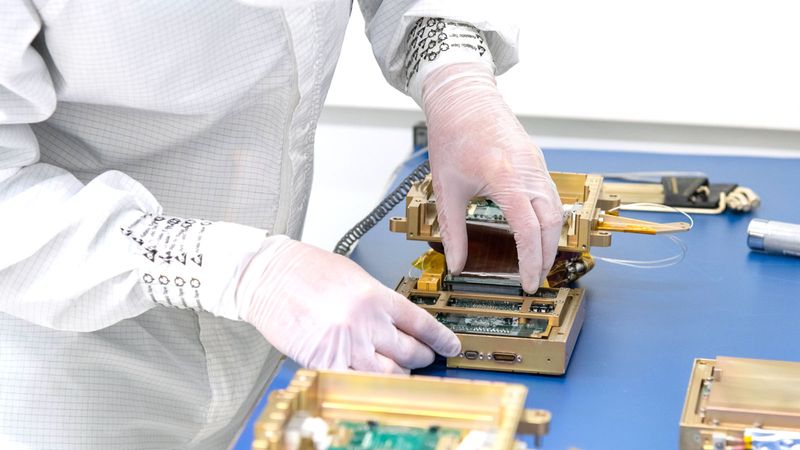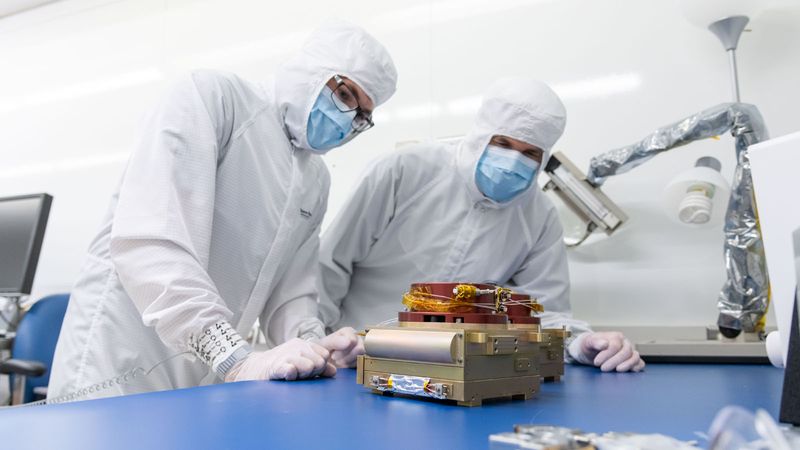
The Carruthers ultraviolet cameras are seen in this March 20, 2023, photo being assembled in an SDL cleanroom on USU’s Innovation Campus to keep camera optics free of contamination. Three camera chassis segments are stacked and fastened together during the final assembly. The camera electronics are visible inside the chassis. (Photo Credit: SDL/Allison Bills)
Utah State University’s Space Dynamics Laboratory is building two key flight camera systems for a NASA spacecraft that will explore the layer of the atmosphere where Earth meets space. The two Far Ultraviolet, or FUV, cameras will serve as the primary science instruments for the Carruthers Geocorona Observatory.
The Carruthers Geocorona Observatory will survey the exosphere — the outermost layer of Earth’s atmosphere — from Lagrange point 1, commonly referred to as L1. L1, about 1.5 million kilometers from Earth, is a point in space where the gravitational pull of Earth and the Sun is equal and opposite, which means the Carruthers Geocorona Observatory will remain in a stable orbital position while it conducts its science mission.
The Carruthers Geocorona Observatory is led by Principal Investigator Lara Waldrop at the University of Illinois Urbana-Champaign and is managed by NASA’s Heliophysics Division.
“In 2021, NASA commissioned SDL to develop and test two FUV cameras for the Carruthers mission to advance our understanding of the exosphere,” said Bennett Keller, SDL’s Carruthers program manager. “This layer of Earth’s atmosphere is not well understood, and the SDL-built cameras will play a crucial role in gathering data to determine its size, shape, density, and how it interacts with Earth and space.”
SDL is also building two filter wheels for the mission, one for each camera. The filter wheels enable the cameras to examine different frequency bands of FUV light, each of which can reveal nuances of the atmosphere’s behavior.
The exosphere extends from an altitude of about 500 kilometers above Earth’s surface to the edge of space, which is about 10,000 kilometers above Earth’s surface. The exosphere is composed mainly of hydrogen and helium gas along with traces of other elements like oxygen and nitrogen. It is also the region where many spacecraft orbit Earth, and it plays a critical role in protecting the planet from solar wind and other harmful radiation from space.
The air is extremely thin in the exosphere, and the gas molecules are widely spaced apart. At this altitude, Earth’s gravity is very weak, and the molecules are no longer held in place by it. Additionally, elements in the exosphere are broken down by sunlight. Because of these conditions, the atoms can escape into space, and the exosphere gradually blends into the cold vacuum of space. The cameras that SDL is building for the Carruthers mission will focus on observing this natural process of atmospheric escape.
Atmospheric escape played a significant role in the depletion of Mars’ atmosphere and the loss of water from its surface. In addition, atmospheric escape has implications beyond our solar system and affects the habitability of exoplanets. By studying Earth’s atmosphere, scientists can expand their knowledge of atmospheres in the wider universe.
The Carruthers Geocorona Observatory was named in honor of George Carruthers, a NASA physicist and inventor who designed the first lunar ultraviolet camera used during the Apollo 16 mission in 1972. Based on his early work, scientists use FUV cameras to observe emissions from molecules and ions in Earth’s upper atmosphere that are excited by the Sun’s ultraviolet radiation. These emissions can provide information about the upper atmosphere’s temperature, density, and composition, as well as the effects of space weather on the region.
“The development of the FUV cameras for the observatory is part of SDL’s long-standing tradition of providing NASA with critical science instruments that help advance our understanding of the universe and protect space-based technology and astronauts,” said Keller. “SDL is proud to work under the leadership of the NASA Heliophysics team and Dr. Waldrop on this unprecedented mission.”
Planned for launch in 2025, the Carruthers Geocorona Observatory will share a ride to space with NASA’s Interstellar Mapping and Acceleration Probe.
Headquartered on Utah State University’s Innovation Campus in North Logan, UT, the Space Dynamics Laboratory is a nonprofit organization and a Department of Defense University Affiliated Research Center owned by USU. More than 1,000 dedicated SDL engineers, scientists, business professionals, and student employees solve technical challenges faced by the military, science community, and industry and support NASA’s vision to explore the secrets of the universe for the benefit of all. SDL has field offices in Albuquerque, NM; Chantilly, VA; Dayton, OH; Huntsville, AL; Ogden, UT; and Stafford, VA. For more information, visit www.sdl.usu.edu.

Contact
- SDL Public Relations
- 435-713-3054
- pr@sdl.usu.edu